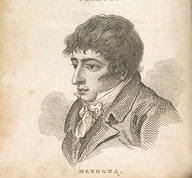Dear Readers,
Today's Post comes to you from the desk of Col. Le Chevalier de Valois:
"Men (including Gentlemen) settling their disputes or just have a
little sport, through unarmed combat is hardly a new concept.
In the mid-18th century Bare Knuckle Boxing and Prize fighting began
to gain more popularity. Formal (or at least semi-formal) rules were
developed and Boxing began to gain notice and respectability.
Interestingly, the increased interest in Boxing came at a time when
duels (primarily with swords) were on the decline. In addition, you
see an increased interest in physical culture, of which Boxing was
often an important part.
 | |
| "Gentleman" John Jackson 1769-1845, Champion of England 1795. Lord Byron received instruction at Jackson's academy for gentlemen on 13 Bond Street. |
Clubs, like Gentleman Jackson’s frequently by Lord Byron, became very
popular in late 18th and early 19th century London. Gentlemen were
often expected to be able to box, ride, drive, shoot a pistol and know
a bit of sword work.
 |
| Daniel Mendoza 1764-1836, Champion of England 1792-1795. Know as the "father of scientific boxing" and a favourite of the Prince of Wales. |
In The Pink Carnation Series by Lauren Willig and The Memoirs of a Bow
Street Runner Series by T.F. Banks several important characters are
skilled pugilists. In the memoirs of a Bow Street Runner the main
character Henry Morton routinely visits Gentleman Jackson’s Club to
box with Lord Byron. These characters are all shown to be in better
physical condition and better able to ‘take care of business’ because
of their boxing training.
 |
| "Jem" James Belcher 1781-1811. Know as the 'The pet of the Fancy' and 'the Napoleon of the ring'. Champion of All England 1800-1805 |
Why a Bare Knuckle Boxing article at this moment? Well, recently
several gentlemen of my acquaintance were able to join me for the
filming of a book trailer for Delilah Marvelle’s upcoming book Forever
a Lord. This book (and the one before it Forever a Lady) features a
fair amount of bare knuckle fighting. In the trailer the main scenes
revolve around one such fight that the main character is in."
Here is the Trailer:
Come out Swinging,
~ Le Chevalier
Online Images Courtesy of:
The British Library
The Olympic Book Fair
Powells Books
Amazon Books
Sources & further Reading:
Bell's Life In London (an English Sporting Chronicle 1822-1886)
The Truth Teller (New York City's first Catholic newspaper 1820's)
Egan, Pierce (1813-1828) Boxiana
Banks, T.F. (2001, 2003). Memoirs of a Bow Street Runner (two books)
Marvelle, Delilah (2012). Forever a Lady
Marvelle, Delilah (2012). Forever a Lord
Willig, Lauren (2005-present). Pink Carnation Series (currently nine books)



























